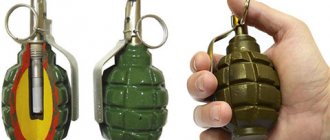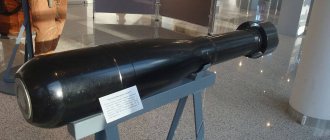X-101 cruise missile at the strategic bomber airfield in Engels Modern air defense systems pose a truly mortal threat to any aircraft, including even those made using stealth technology, but not to Russian strategic bombers. Neither the Tu-95 nor the Tu-160 simply needs to enter the range of any air defense, because their main weapons are air-launched cruise missiles capable of hitting targets thousands of kilometers away from the launch point. The most advanced types of such weapons today are the X-101 and X-102 missiles, which have already been tested in real combat operations.
History of creation
In the 1980s, the main weapon of Russian strategic bombers became the Kh-55 cruise missiles, capable of hitting targets at a distance of 2,500 kilometers. They could be used by both the latest Tu-160 at that time and the Tu-95MS, which was well mastered by pilots. It should be noted that the initial modification of the X-55 was not very accurate - the probable circular deviation reached 100 meters. When using a nuclear warhead this was acceptable, but for a conventional warhead it was too much.
Meanwhile, it was already known that the United States was developing a new cruise missile for the B-52 bomber, designated AGM-129ACM. It promised to become not only more accurate than the X-55, but also longer-range - the maximum flight distance was up to 3,700 kilometers.
It was possible to prevent falling behind a potential enemy in two main ways - to improve the characteristics of the X-55 or to start creating some other, fundamentally new missile.
American cruise missile AGM-129 ACM. It had a noticeably shorter range than the X-101. Due to its large dimensions, it was never possible to place it in the bomb bay of any aircraft.
The designers of the Dubna MKB "Raduga" decided to follow these two paths at the same time. The X-55 has undergone a number of upgrades, after which its capabilities have increased dramatically. At the same time, work began on two new projects, which competed with each other for some time.
At first, the project of the new generation X-90 rocket looked most promising. In this case, a radical increase in flight range was not planned - this parameter was supposed to be “only” 3000 kilometers. The emphasis was on another characteristic - speed. The X-90 could become the first example of hypersonic weapons.
The prototype of the rocket, the GELA aircraft, was built and tested, but almost immediately the designers were faced with a huge number of different problems that could not be solved. Development of the X-90 had to be stopped. One of the reasons for this failure, of course, was the sharp reduction in funding after the collapse of the USSR. The time for hypersonic weapons in the 90s had not yet come.
The main efforts were transferred to the creation of an approximate analogue of the AGM-129, which became the X-101 cruise missile. Of course, there can be no question of copying in this case - the Russian design is completely original, it’s just that it was made largely with an eye to the main characteristics of the American model. In particular, considerable attention was paid to reducing radar signature and increasing hit accuracy.
The AGM-129 entered service with the US Air Force in 1990, and was already withdrawn from service in 2007. As you might guess, the fate of the X-101 turned out to be much more complicated. The first test launches were carried out only in 1998.
Kh-101 missiles under the wing of a Tu-95MSM
The Tu-95MS was initially used as a carrier aircraft. Over the next three years, testing continued, and in 2002, serial production of new weapons was to begin in Smolensk.
Then, apparently, there was some kind of hitch. In any case, according to modern information, serial production of new missiles began no earlier than 2011. It can be assumed that throughout the “zero” years, the X-101 and its “sister” X-102 were finalized.
In addition, it is necessary to take into account the fact that the Tu-95MS and Tu-160 combat aircraft either could not use the new missiles at all, or were not able to fully realize their potential. The bombers had to be modernized, which took a lot of time and required additional costs.
Unfortunately, it is not possible to establish the exact date of adoption of the X-101 and X-102 into service. The first reports of this were published in 2012, but did not receive official confirmation. Apparently, the Russian Ministry of Defense made the final decision about a year later. In 2015, these weapons were used against terrorist groups located in Syria.
Slow and dangerous
Long-range, precision-guided subsonic cruise missiles became a real threat in the 1980s. The most famous embodiment of this threat has long been the American Tomahawk, a sea-launched cruise missile that is still produced in various modifications.
All versions of the Tomahawk, designed to destroy ground targets, have the following in common: relatively small dimensions - the missile is made in a 533 mm caliber, which allows it to be launched through the torpedo tubes of submarines; relative simplicity of design - this is a subsonic aircraft with a turbojet engine that does not experience strong overloads in flight; a developed control system that ensures flight in terrain-following mode and high hit accuracy, and in the latest modifications, also the ability to retarget in flight.
Launch of a Tomahawk cruise missile from the American destroyer USS Barry
The United States has produced several thousand missiles of this type, and hundreds of Tomahawks have been used in numerous local conflicts, from the Gulf War in 1991 to the present day.
However, in the 1980s, this missile was also intended to destroy targets on the territory of the USSR - it was believed that low-altitude flight and high accuracy made it a serious threat even to dense Soviet air defense, despite the relatively low flight speed, and the possibility of using nuclear weapons parts, combined with high accuracy, made it possible to destroy, including well-protected small-sized targets.
AGM-86 ALCM cruise missiles under the wing of an American B-52 strategic bomber
The matter was not limited to ship-based missiles: in addition to the naval BGM/RGM/UGM-109 Tomahawk, the AGM-86 ALCM missile for strategic bombers and the “land” version of the naval missile - BGM-109G GLCM - for ground-based missile units of the US Air Force went into production .
This threat was taken seriously: American new generation cruise missiles, even in the early stages of development in the early 1970s, became one of the main incentives for updating the USSR's air defense, which led to the creation of anti-aircraft missile systems of the S-300 family and MiG-31 fighter-interceptors, and to ensure the ability to intercept low-altitude and stealthy targets required a serious leap in the development of domestic military radio electronics.
Despite the intensive development of hypersonic technologies, subsonic cruise weapons do not lose their relevance. Thus, the X-55 missiles developed for strategic aviation back in the 1980s were replaced by the ultra-long-range X-101 and X-102. They differ from each other in their warhead - non-nuclear and nuclear, respectively. The first X-101s were armed with Tu-95 and Tu-160 bombers in the early 2010s.
The X-101 strategic cruise missile, in terms of its characteristics, undoubtedly has no analogues in the world. The missile's flight range is 5,500 kilometers, possible deviation from the target at a maximum distance of 5 meters. The eight-meter projectile is invisible to radar and, depending on the situation, can change its flight altitude from 30 meters to 10 kilometers.
The X-101 (X-102 version with a thermonuclear warhead), (pronounced "Kha-101") is a strategic air-to-ground cruise missile using radar signature reduction technologies. Developed by the Raduga design bureau (1995-2013).
Design
The engine is located inside the rocket. The missile is made on a new technological basis and has exclusively Russian components. A combined guidance system is used: not only an inertial system with optical-electronic correction, but also a homing head in the final section. It can also receive comprehensive information both on the route and on the coordinates of the target. Compared to and unlike missiles of the previous generation, there is a fundamental possibility of changing the target when the missile is already in flight.
The nuclear version (X-102) carries a warhead with a yield, according to various sources, of 250 kilotons or 1 megaton.
According to test results, the missile has a circular probable deviation (CPD) of 7 m at a range of 5500 km, and is also capable of destroying moving targets with an accuracy of up to 10 m.
Cruise missile X-101 characteristics
| Parameter | Meaning |
| Developer | MKB "Rainbow" |
| Year the tests began | 1999 |
| Length, m | 7,45 |
| Diameter, mm | 742 |
| Wingspan, m | 3 |
| Starting weight, kg | 2200—2400 |
| Weight of warhead, kg | 400 |
| Fuel weight, kg | 1250 |
| Speed, m/s, cruising | 190—200 |
| Speed, m/s, maximum | 250—270 |
| Maximum range, km | 5500 km |
| Flight profile | changeable |
| Flight profile height, m | variable from 30—70 to 10,000 |
| EPR, m 2 | 0,01 |
| Homing head type | optoelectronic correction system + TV (media) INS + laser altimeter/optical image based on standards of correction areas + (probably) at the final stage of flight - optical or radar seeker |
| Power point | Engine DTRD TRDD-50A with a thrust of 450 kg |
| Accuracy (QUO), m | 10 |
| Nuclear version of the missile | X-102 with a thermonuclear charge with a power of 250 kt or 1 Mt |
| Carriers | • Tu-160 (12 missiles in two internal compartments) • Tu-95 (8 missiles on an external sling) |
Operating principle and design of the rocket
When developing the X-101, the designers of the Raduga IKB made extensive use of the experience gained in the design of the X-55. At the same time, it cannot be said that these two missiles are similar to each other. To reduce the radar signature of the X-101, its body was given a rather unusual shape, which led to a decrease in the effective dispersion surface (ECS).
Main projections of the Kh-101/102 rocket
In addition, the aerodynamic design has been changed - if the X-55 was a mid-wing, then the X-101 is a low-wing. Because of this feature, the previous method of extending the wings during launch from special internal niches of the body has become inapplicable - the load-bearing planes of the new rocket are initially placed under the body and unfolded after launch.
The tail of the X-101 is also foldable. The thrust of the power plant, according to some sources, is 360 kgf (according to other sources, up to 450 kgf). The rocket engine is probably a bypass turbojet RD-95TM-300. Its dimensions are small enough to fit into a relatively small case. In the “transport” position, the engine is hidden in a special niche, from which it extends after start. A similar scheme was used on the X-55.
Navigation during the flight is provided by an inertial system that uses pre-prepared digital maps of the area, which makes it possible to follow a given route with maximum accuracy. In addition, the rocket is equipped with a communication module with the Glonass satellite navigation system. Height correction is performed using an optical-electronic laser rangefinder.
Targeting at the final stage is carried out by the homing head. According to various sources, it can be either radar or television with an optical-electronic recognition module. The flight mode is usually set at the airfield (retargeting is also allowed after launch) - during the flight to the target, the current altitude 101 can change from 30 to 6000 meters.
design
It is powered by a single 400 kg Ukrainian-made, Motor Sich OJSC R95-300 turbofan engine with retractable wings for cruising efficiency. It can be launched from both high and low altitudes, and can fly at subsonic speeds at low altitudes (below 110m/300ft). After launch, the folded wings, empennage and rocket engine are deployed. It is controlled by a combination of inertial guidance system and terrain-aware guidance system, which uses radar and images stored in the on-board computer to find the target. This allows the missile to be aimed at its target with a high degree of accuracy.
The original X-55 had a drop engine; The Kh-65SE had a stationary external turbojet engine, and the Kh-SD had an engine inside the rocket body. Serial versions are equipped with a Russian-made turbofan engine 50A NPO Saturn with increased power of 450 kgf.
Flight performance
Six Kh-101 missiles on a drum launcher in the internal compartment of a Tu-160 aircraft
. Since the Kh-101 is a strategic cruise missile, most information about it is classified. It is possible to indicate its main characteristics only approximately:
| Starting weight | 2.2 – 2.4 tons |
| Warhead weight | 400 kg |
| Range of flight | Up to 5500 km |
| Maximum speed | Up to 1000 km/h |
| Cruising speed | About 730-740 km/h |
| Rocket length | 7450 mm |
| Diameter | 742 mm |
| Wingspan | 3m |
| EPR | 0.01 sq.m (estimated) |
| Circular Probable Deviation (CPD) | 12-20 m |
The Kh-102, unlike the Kh-101, is a missile with a nuclear warhead, the yield of which, according to various sources, ranges from 200 kilotons to one megaton. At what altitude regime the maximum flight range is achieved is not known exactly. At the same time, during testing and practical use of the rocket, higher accuracy was obtained than indicated in the table - the circular probable deviation was no more than 5-7 meters.
Features of missile carriers, Tu-160M and Tu-95MSM bombers
Although test launches of Kh-101 prototypes were carried out from the Tu-95MS strategic bomber, it was no longer suitable for the practical use of new missiles. Modernization was required, during which the aircraft was modified as follows:
- Engines with improved performance have been installed;
- The bomber received a modern sighting and navigation system;
- A new radar station “Novella-NV1.021” was installed;
- Instrumentation equipment has been replaced;
- On the wings there are holders adapted for hanging Kh-101 missiles.
Several bombers of the Tu-95MS-16 submodification were subjected to this modernization. The new version of the aircraft was designated Tu-95MSM. It can carry up to eight X-101s under its wings.
Tu-95MSM launches Kh-101 missile
Sometimes it is erroneously said that the number of missiles can be increased to 16, but this is not so - in this case, the weight of the ammunition would be more than 35 tons, which is more than one and a half times the actual carrying capacity of the aircraft. The Tu-95 is indeed capable of lifting 16 missiles into the air, but only the Kh-55.
Much less information is available about another aircraft armed with the X-101/102 - the Tu-160M supersonic bomber. The fact is that the main “media-covered” direction of modernization of the White Swan was its adaptation to the use of conventional free-falling bombs, while the placement on board of the latest missiles for some reason faded into the background.
It can be assumed that modernized drum launchers were installed in the weapons compartments of the updated Tu-160 - after all, the load on the holders when using the X-101 almost doubled. In addition, the sighting and navigation system of this aircraft probably required updating.
Estimation of the impact force of the Kh-101 and Kh-102 missiles
The usual “conventional” warhead, which the X-101 cruise missile has, weighs 400 kilograms - these are the characteristics of its carrying capacity. This means that the effect of its impact can be compared with the impact of a conventional 500 kg caliber aerial bomb. The Caliber (warhead - 450 kg), Iskander (480 kg) and Tomahawk (450 kg) missiles have approximately the same power. The main advantage of the X-101 compared to them is its enormous flight range.
True, it is not entirely clear how exactly one can take advantage of the increased missile launch distance. For example, when trying to hit strategically important targets in the depths of the United States, the subsonic X-101 will become quite vulnerable to interception, despite its small ESR - after all, the flight will take at least seven hours.
Launch of the X-101 from the bomb bay of a Tu-160 aircraft
A much more interesting feature of the X-101 is the possibility of its use against moving objects. Of course, firing such expensive missiles at tanks would be pointless, but the homing head probably makes it possible to target enemy ships, and this significantly expands the range of combat use. An anti-ship missile with such an impressive range (more precisely, the longest in the world) could make noticeable changes in the balance of power at sea.
Slow and dangerous
Long-range, precision-guided subsonic cruise missiles became a real threat in the 1980s. The most famous embodiment of this threat has long been the American Tomahawk, a sea-launched cruise missile that is still produced in various modifications.
All versions of the Tomahawk, designed to destroy ground targets, have the following in common: relatively small dimensions - the missile is made in a 533 mm caliber, which allows it to be launched through the torpedo tubes of submarines; relative simplicity of design - this is a subsonic aircraft with a turbojet engine that does not experience strong overloads in flight; a developed control system that ensures flight in terrain-following mode and high hit accuracy, and in the latest modifications, also the ability to retarget in flight.
Launch of a Tomahawk cruise missile from the American destroyer USS Barry
The United States has produced several thousand missiles of this type, and hundreds of Tomahawks have been used in numerous local conflicts, from the Gulf War in 1991 to the present day.
However, in the 1980s, this missile was also intended to destroy targets on the territory of the USSR - it was believed that low-altitude flight and high accuracy made it a serious threat even to dense Soviet air defense, despite the relatively low flight speed, and the possibility of using nuclear weapons parts, combined with high accuracy, made it possible to destroy, including well-protected small-sized targets.
AGM-86 ALCM cruise missiles under the wing of an American B-52 strategic bomber
The matter was not limited to ship-based missiles: in addition to the naval BGM/RGM/UGM-109 Tomahawk, the AGM-86 ALCM missile for strategic bombers and the “land” version of the naval missile - BGM-109G GLCM - for ground-based missile units of the US Air Force went into production .
This threat was taken seriously: American new generation cruise missiles, even in the early stages of development in the early 1970s, became one of the main incentives for updating the USSR's air defense, which led to the creation of anti-aircraft missile systems of the S-300 family and MiG-31 fighter-interceptors, and to ensure the ability to intercept low-altitude and stealthy targets required a serious leap in the development of domestic military radio electronics.
Combat use
The first real targets were hit with the X-101 on November 17, 2015. On this day, 16 air-launched cruise missiles fired from Tu-160 bombers hit a number of key facilities belonging to various terrorist groups operating in Syria.
On November 19 and 20, 2015, the White Swans carried out two more strikes against militants. Exactly a year later, the first combat launches of the X-101 from Tu-95MSM aircraft took place. In 2017, the same bombers again used new missiles against terrorists - on July 5 and September 26.
Ground preparation of the Kh-101 missile
In total, more than fifty-four X-101 missiles were used during the Syrian campaign. According to official information from the Russian Ministry of Defense, all of them successfully hit their intended targets, including moving ones. The terrorists tried (apparently at the instigation of their secret foreign sponsors) to belittle the combat qualities of Russian weapons, but the “evidence” they presented convinced few people.











